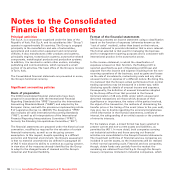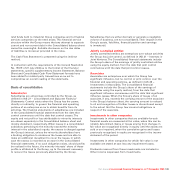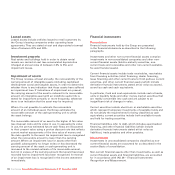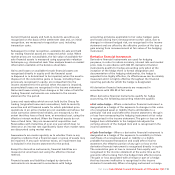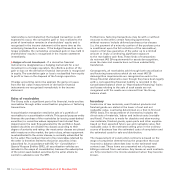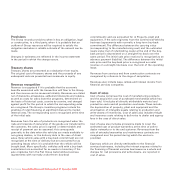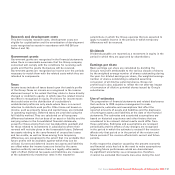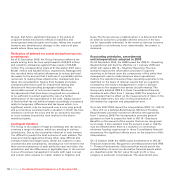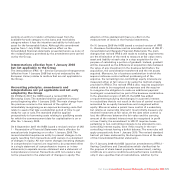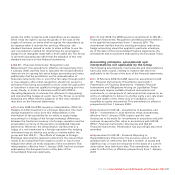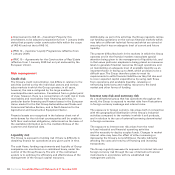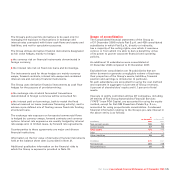Chrysler 2008 Annual Report Download - page 119
Download and view the complete annual report
Please find page 119 of the 2008 Chrysler annual report below. You can navigate through the pages in the report by either clicking on the pages listed below, or by using the keyword search tool below to find specific information within the annual report.Fiat Group Consolidated Financial Statements at 31 December 2008118
year which differ from estimates, and which therefore might
require adjustments, even significant, to be made to the
carrying amount of the items in question, which at the present
moment can clearly neither be estimated nor predicted.
The main items affected by these situations of uncertainty are
the allowances for doubtful accounts receivable and
inventories, non-current assets (tangible and intangible assets),
the residual values of vehicles leased out under operating
lease arrangements or sold with buy-back clauses, pension
funds and other post-employment benefits, and deferred tax
assets.
The following are the critical judgements and the key
assumptions concerning the future, that management has
made in the process of applying the Group accounting policies
and that have the most significant effect on the amounts
recognised in the Consolidated financial statements or that
have a significant risk of causing a material adjustment to the
carrying amounts of assets and liabilities within the next
financial year.
Allowance for doubtful accounts
The allowance for doubtful accounts reflects management
estimate of losses inherent in wholesale and retail credit
portfolio. The Group reserves for the expected credit losses
based on past experience with similar receivables, current and
historical past due amounts, dealer termination rates, write-
offs and collections, the careful monitoring of portfolio credit
quality and current and projected economic and market
conditions. Should the present economic and financial crisis
persist or even worsen, this could lead to a further
deterioration in the financial situation of the Group’s debtors
compared to that already taken into consideration in
calculating the allowances recognised in the financial
statements.
Allowance for obsolete and slow-moving inventory
The allowance for obsolete and slow-moving inventory reflects
management’s estimate of the loss in value expected by the
Group, and has been determined on the basis of past
experience and historical and expected future trends in the
used vehicle market. The present economic and financial crisis
could cause a further deterioration in conditions in the used
vehicle market compared to that already taken into
consideration in calculating the allowances recognised in the
financial statements.
Recoverability of non-current assets (including goodwill)
Non-current assets include property, plant and equipment,
investment property, intangible assets (including goodwill),
investments and other financial assets. Management reviews
the carrying value of non-current assets held and used and
that of assets to be disposed of when events and
circumstances warrant such a review. Management performs
this review using estimates of future cash flows from the use
or disposal of the asset and suitable discount rate in order to
calculate present value. If the carrying amount of a non-
current asset is considered impaired, the Group records an
impairment charge for the amount by which the carrying
amount of the asset exceeds its estimated recoverable amount
from use or disposal determined by reference to its most
recent Group plans.
In view of the present economic and financial crisis, the Fiat
Group has the following considerations in respect of its future
prospects:
In the current situation, when preparing figures for the
Consolidated financial statements for the year ended 31
December 2008 and more specifically for carrying out
impairment testing of tangible and intangible assets, the
various Sectors of the Group have taken into consideration
their expected performance for 2009, with assumptions and
results consistent with the statements made in the section
Significant events subsequent to the year end and outlook.
In addition, for the plans of subsequent years they have made
prudent revisions to their respective 2007-2010 plans to take
account of an economic and financial situation and market
conditions which have undergone profound change as the
result of the present crisis. No requirement to recognise
significant impairment losses arose following the revision
of the planned data in this way.
Further, should the plan assumptions deteriorate further the
following is noted:
– The Group’s tangible assets and intangible assets with
a finite useful life (which essentially regard development
expenditure) relate to recent models or products having
a high technological content in line with the latest
environmental laws and regulations, which consequently
renders them competitive in the present economic situation,
especially in the more mature economies in which particular


